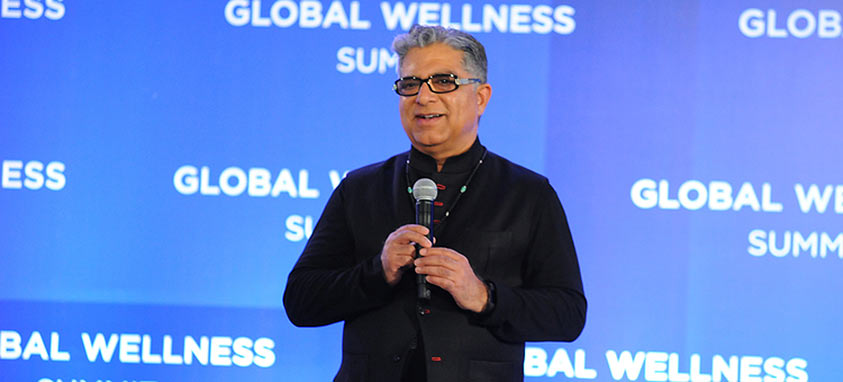The Global Wellness Summit that took place Nov. 13-15 in Mexico City drew more than 470 delegates from 40 counties to discuss strategies to build a well world. Compared to the Kyoto, Japan, gathering to combat climate change, the summit drew leaders from a variety of entities including medical centers such as Mayo and Cleveland clinics, Harvard and Duke universities and workplace wellness spokespeople such as Johnson & Johnson and Zappos.
“The Mexico City Summit was a watershed moment, because passionate leaders from economics, medicine, government, technology, spa/wellness, travel, education and the arts came together to debate how to bring preventative health into our chronic disease and healthcare cost burdened world much like when the world first came together in Kyoto to declare solidarity against climate change,” says Susie Ellis, CEO and chairman for the Global World Summit.
The event was held at St. Regis Mexico City. Among the participants was Deepak Chopra.
Here are 10 shifts in wellness trends that could help improve health and well-being:
1. Cracking the Genome to Cracking the Epigenome
We’ve had years of promises that “cracking” the human genome would eradicate all kinds of diseases, but experts like Dr. Deepak Chopra explained that the future is decoding the epigenome, that DNA which is ceaselessly modified by lifestyle choices and environment. Research is underway pinpointing the 20 or so genetic markers (out of 2,400) that are actually modifiable by healthy living. Epigenetic breakthroughs are coming.
2. Optional to Mandatory Wellness
Global economist Thierry Malleret did the math on the skyrocketing cost of chronic diseases ($47 trillion worldwide over the next 20 years, or 30 percent of GDP), and a world aging like never before (800 million people now over 60), and concluded that wellness can no longer be optional. More governments will take legislative action to require or reward healthier behavior. This isn’t a “maybe”, it’s near certainty: wellness tax incentives, and insurance companies rewarding healthy behavior (as tracked by wearable/implantable devices) will arrive by 2020. Initiatives that reward and support people will be most successful, and ultimately even appreciated, because they work.
3. In Your Face to Imperceptible Wellness
Wellness has historically been something you “do.” The future is more wellness baked seamlessly into the fabric of our lives: dawn-simulating lighting waking you up gently (goodbye shrieking alarm clock); bed sensors monitoring your sleep, making instant ventilation/comfort changes; and responsive materials (using haptic technologies), including fabrics that cuddle us or clothes that deliver the perfect massage. The prediction? Even futuristic “living” buildings that monitor residents’ oxygen, stress and hunger levels to adapt homes in real-time even ”growing” you a new room!
4. Workplace Wellness “Programs” to Total Cultures of Wellness at Work
New Global Wellness Institute research forecasts that workplace wellness approaches will change radically: the current “program” mentality will die a natural death because they’re not working. The future is meaningful, real “cultures” of health at work, tackling everything from physical, to emotional, to financial wellness: fair pay, healthy workspaces, inclusion of families and virtual workers, and tackling fast disappearing work/life balance, like mandating vacations and that workers unplug from always-on, wired work. Companies will replace “ROI” obsessions with measuring total “return-on-value” (ROV), with mounting evidence that happy, healthy workers not only reduce healthcare costs, but also drive recruitment, retention and much higher profits.
5. Medicine vs. Wellness to Truly Integrative Healthcare
Integrative medicine has been talked about for decades, but is finally happening. Medical leaders from the Mayo and Cleveland Clinics, Harvard and Duke agreed that now we’re at the real “inflection point.” Every leading medical center either has, or is planning, a wellness/integrative center. And if doctors have always been reimbursed for treating disease, a future where they get remunerated for preventing it looks possible (as in countries like China, Norway, and Singapore). Medicine will incorporate more wellness, but the reverse will also be true. One example: the Mayo Clinic Healthy Living Program coming to the Mandarin Oriental, Bodrum, Turkey in Jan. 2016.
6. Medical Technology Breakthroughs: Ingestible Health Trackers to Stem Cells
Medical technology breakthroughs presented were mind blowing. Ingestible, health-tracking nanochips that monitor 50 biological functions 24/7 will make clunky wearables seem prehistoric, and usher in a new era of precision, preventative and personalized medicine. And new directions in stem cell harvesting/freezing (no more storing cells from a baby’s umbilical cord, but rather the non-invasive extraction of stem cells from teeth) have the ability to make any cell “young” again: whether bone, insulin, pancreatic, heart, liver, brain, eye, collagen or elastin, cells. Which may be the path to curing diseases like ALS, Parkinson’s and Alzheimer’s.
7. Wellness Homes: Big Growth and Big Premiums for Owners/Investors
More homes, communities and even cities are being master-planned from the ground up for human health. New examples: Mayo Clinic’s ambitious 20-year project to turn its base of Rochester, MN into a “City of Health” and Delos Living’s project to transform part of Tampa City, FL into a 40-acre healthy city. Wellness living is certainly good for people, and according to a panel of real estate developers, it’s also good for the bottom line. Preliminary numbers indicate very healthy investment returns: between a 5-35 percent premium on wellness-branded, single-family homes; a 7-10 percent premium for wellness rentals; and a 15-30 percent average daily rate premium for wellness-branded hotels.
8. Superfood and Diet Trend Hysteria to Sane Eating
Given the recent, hysterical obsessions with the next superfood or diet trend, experts are suggesting that we may be experiencing a collective, global eating disorder. Nutritionists noted that what we eat has changed more in the last 40 years than in the previous 40,000. Superfoods are on a collision course with sustainability: our manic importation of chia seeds, quinoa, goji berries, etc. is disturbing global ecosystems. The future? Clean, sustainably sourced (from our own backyard), personally intuitive foods and a welcome return to eating as pleasure. (Yes, you can skip the kale.)
9. Wellness Travel Booming: Emerging Markets to New “Pairings” for Wellness
Omer Isvan (president, Servotel Corp) summarized: “Wellness will only become a bigger player in the destination resort space, while resorts without wellness and ‘purpose’ will decline.” In general, experts agreed that the heart of wellness tourism is the “transformational experience”: less about the destination, and more about how the experience alters a person’s mind, body and soul. Jean-Claude Baumgarten (former president, World Travel & Tourism Council) noted that because “wellness” can sometimes remain a hazy concept for travelers, that we’ll increasingly see it paired with every travel category imaginable: wellness and…“adventure,” “culinary and wine,” “cruise,” “cultural,” “safari”…you name it.
10. Wellness for the Wealthy Few to the Democratization of Wellness
A powerful thread running through the Summit was the need to bring wellness to more members of society: the young and old, wealthy and poor, the healthy and ill. As Agapi Stassinopoulus stated in her wrap-up keynote: “It’s time to take wellness to the masses.”
Conscious Capitalism: For companies and individuals, success will increasingly be measured not by net worth but by “net good.” Going forward, the winning brands will be charitable, collaborative and creative.
In Sickness and In Health: Forty percent of people will get some type of cancer in their lifetime, and the spa and wellness industries will finally start embracing and retraining for them – eliminating the fear of, and myths about, treating those with the “Big C.”
Meditation and Mindfulness Go Mainstream: Nothing has been talked about more in recent years than mindfulness, but people will finally start practicing it because it’s about to become far more accessible and unintimidating. Even Weight Watchers International revealed that it’s expanding its focus from weight loss to total wellness, hinting that their nearly one million weekly meeting-goers will be introduced to meditation.
To Build a Well World, Focus on Children: Boutique fitness studios are rolling out myriad classes for children. Spas/wellness retreats are now increasingly creating serious wellness programming for kids: from healthy cooking classes, to yoga, to meditation. In India, meditation and yoga are now taught to millions of school children daily.
Read full report click here.




